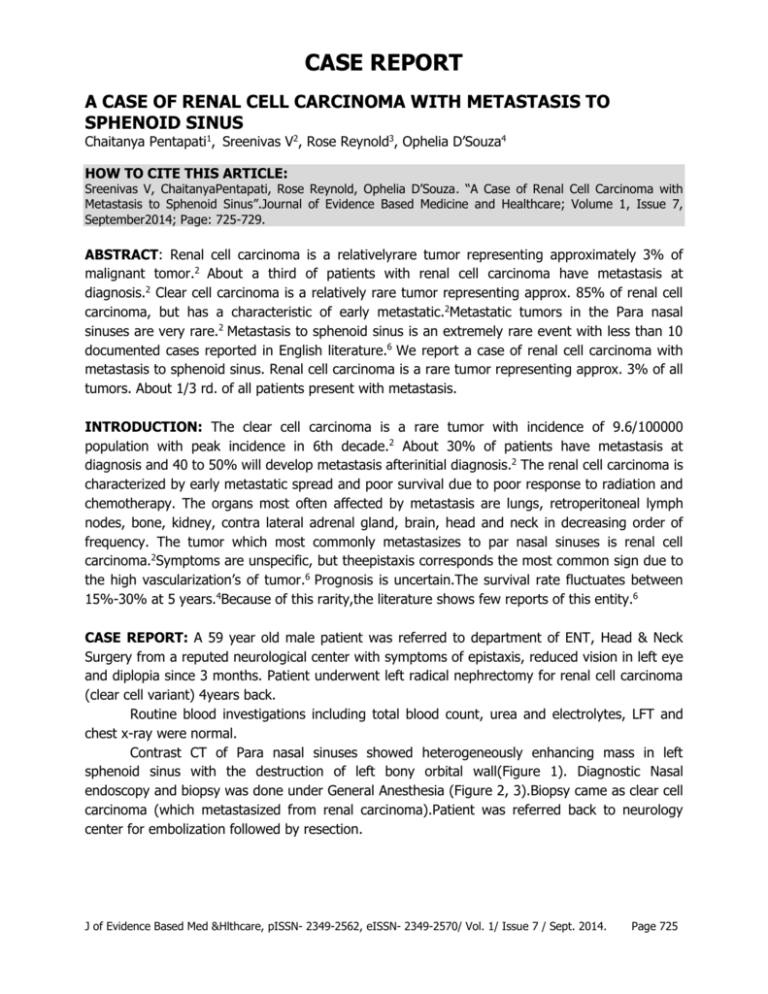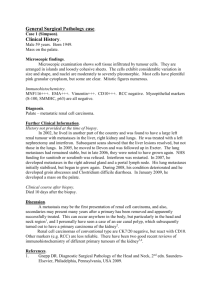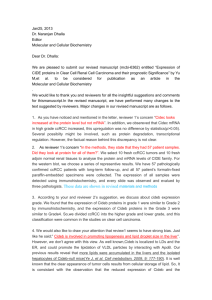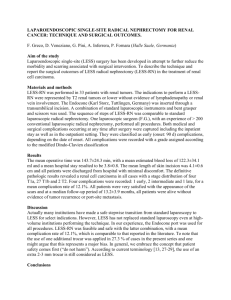a case of renal cell carcinoma with metastasis to sphenoid sinus
advertisement

CASE REPORT A CASE OF RENAL CELL CARCINOMA WITH METASTASIS TO SPHENOID SINUS Chaitanya Pentapati1, Sreenivas V2, Rose Reynold3, Ophelia D’Souza4 HOW TO CITE THIS ARTICLE: Sreenivas V, ChaitanyaPentapati, Rose Reynold, Ophelia D’Souza. “A Case of Renal Cell Carcinoma with Metastasis to Sphenoid Sinus”.Journal of Evidence Based Medicine and Healthcare; Volume 1, Issue 7, September2014; Page: 725-729. ABSTRACT: Renal cell carcinoma is a relativelyrare tumor representing approximately 3% of malignant tomor.2 About a third of patients with renal cell carcinoma have metastasis at diagnosis.2 Clear cell carcinoma is a relatively rare tumor representing approx. 85% of renal cell carcinoma, but has a characteristic of early metastatic.2Metastatic tumors in the Para nasal sinuses are very rare.2 Metastasis to sphenoid sinus is an extremely rare event with less than 10 documented cases reported in English literature.6 We report a case of renal cell carcinoma with metastasis to sphenoid sinus. Renal cell carcinoma is a rare tumor representing approx. 3% of all tumors. About 1/3 rd. of all patients present with metastasis. INTRODUCTION: The clear cell carcinoma is a rare tumor with incidence of 9.6/100000 population with peak incidence in 6th decade.2 About 30% of patients have metastasis at diagnosis and 40 to 50% will develop metastasis afterinitial diagnosis.2 The renal cell carcinoma is characterized by early metastatic spread and poor survival due to poor response to radiation and chemotherapy. The organs most often affected by metastasis are lungs, retroperitoneal lymph nodes, bone, kidney, contra lateral adrenal gland, brain, head and neck in decreasing order of frequency. The tumor which most commonly metastasizes to par nasal sinuses is renal cell carcinoma.2Symptoms are unspecific, but theepistaxis corresponds the most common sign due to the high vascularization’s of tumor.6 Prognosis is uncertain.The survival rate fluctuates between 15%-30% at 5 years.4Because of this rarity,the literature shows few reports of this entity.6 CASE REPORT: A 59 year old male patient was referred to department of ENT, Head & Neck Surgery from a reputed neurological center with symptoms of epistaxis, reduced vision in left eye and diplopia since 3 months. Patient underwent left radical nephrectomy for renal cell carcinoma (clear cell variant) 4years back. Routine blood investigations including total blood count, urea and electrolytes, LFT and chest x-ray were normal. Contrast CT of Para nasal sinuses showed heterogeneously enhancing mass in left sphenoid sinus with the destruction of left bony orbital wall(Figure 1). Diagnostic Nasal endoscopy and biopsy was done under General Anesthesia (Figure 2, 3).Biopsy came as clear cell carcinoma (which metastasized from renal carcinoma).Patient was referred back to neurology center for embolization followed by resection. J of Evidence Based Med &Hlthcare, pISSN- 2349-2562, eISSN- 2349-2570/ Vol. 1/ Issue 7 / Sept. 2014. Page 725 CASE REPORT FIGURE 1 FIGURE 2 FIGURE 3 DISCUSSION:Primary tumors of PNS are very rare constituting 5% of all head and neck tumors.4 Metastatic tumors of PNS are even rare comprising 0.25 to 5% of all PNS tumors.4 Kidney (renal cell carcinoma), lung, breast, testis (seminoma), gastrointestinal tract, and thyroid gland are, in order of frequency, the most common locations of the primary tumors that give origin to these metastases.5 The maxillary sinuses are most commonly affected by metastatic tumors to the sinonasal region, followed in frequency the ethmoid sinus, frontal and sphenoid.6 Epistaxis is the most common symptom due to highly vascular nature of renal cell carcinoma. Cranial nerve palsies involving (II, III, IV & VI) is common in sphenoid metastasis.2 Route of spread:It occurs due to the presence of valve less intercommunicating vertebral veins allowing intra-abdominal metastasis to bypass heart and lungs and communicate directly with veins of head and neck (pterygoid plexus, cavernous sinus, superior part of pharyngeal plexus).6 Patients with distant metastasis from renal cell carcinoma have poor survival 5-7% at 5 years. (With isolated metastasis it increases to 25% at 5 years).4 As the tumor is chemo and radio resistant resection is best treatment wherever feasible. Unresectable tumors can be treated with chemotherapy (vinblastine, 5FU, flourodeoxyuridine), immunotherapy, cellular therapy or hormonal therapy.2 CONCLUSION: This review highlights the rarity of the case and the importance in the differential diagnosis of sinus disease6 J of Evidence Based Med &Hlthcare, pISSN- 2349-2562, eISSN- 2349-2570/ Vol. 1/ Issue 7 / Sept. 2014. Page 726 CASE REPORT REFERENCES: 1. FischettiG, CuzariS, LeoneP, De MartinoP, MusyM, MarianeS, FraioliA. and ValentiniM. A.“Immunotherapy in the Management of Metastatic Renal Carcinoma”, Minerva Urologica e Nefrologica, Vol. 54, No. 2, 2002, pp. 113-117. 2. KoutnouyanH. A, RumoreG. J. and KahnJ. M.“Skull Metastasis from Renal Cell Carcinoma. Case Report and Literature Review,” Annals of Otology, Rhinology and Laryngology, 1998; 107(7): pp. 598-602. 3. Flocks R. H. and BoatmanD. L.“Incidence of head and neck metastases from genito urinary neoplasms,” Laryngoscope, 83(9):pp. 1527–1539, 1973. 4. PatelM, ThinakkalR, SoboroffB, and BorkenhagenR.“Renal metastatic epistaxis: case report and update of literature, 1966–1978,” Illinois Medical Journal, 158(5): pp. 335–339, 1980. 5. SalehH. A, O'FlynnP, and N. S. Jones.“Prostatic metastases in the nose and paranasal sinuses,” Journal of Laryngology and Otology, 107(7):pp. 629–632, 1993. 6. PeterssonF, HuiT. S, LokeD, and PuttiT. C.“Metastasis of occult prostatic carcinoma to the sphenoid sinus: report of a rare case and a review of the literature,” Head and Neck Pathology, 6(2): pp. 258–263, 2012. AUTHORS: 1. ChaitanyaPentapati 2. Sreenivas V. 3. Rose Reynold 4. Ophelia D’Souza PARTICULARS OF CONTRIBUTORS: 1. Senior Resident, Department of ENT, Head & Neck Surgery, St. John’s Medical College Hospital. 2. Professor, Department of ENT, Head & Neck Surgery, St. John’s Medical College Hospital. 3. Junior Resident, Department of ENT, Head & Neck Surgery, St. John’s Medical College Hospital. 4. Professor, Department of ENT, Head & Neck Surgery, St. John’s Medical College Hospital. NAME ADDRESS EMAIL ID OF THE CORRESPONDING AUTHOR: Dr. Chaitanya P, H. No. 845, 20th B Main, Koramangala 8th Block, Bangalore. E-mail: chaituamc@gmail.com Date Date Date Date of of of of Submission: 01/09/2014. Peer Review: 02/09/2014. Acceptance: 03/09/2014. Publishing: 10/09/2014. J of Evidence Based Med &Hlthcare, pISSN- 2349-2562, eISSN- 2349-2570/ Vol. 1/ Issue 7 / Sept. 2014. Page 727








